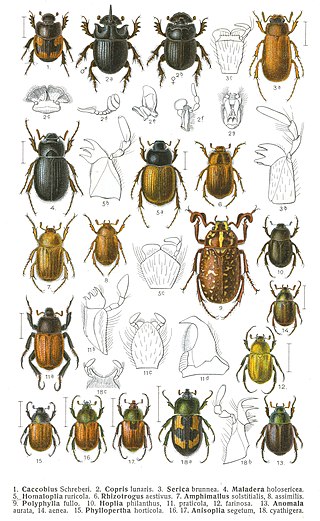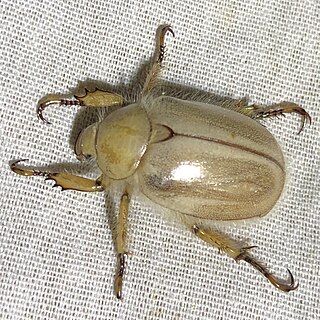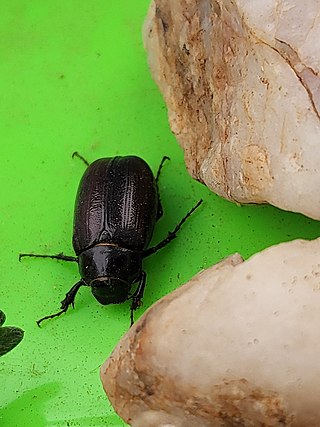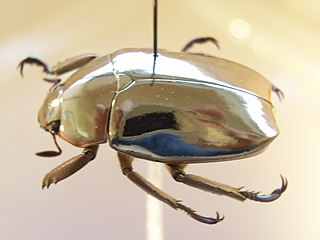
The family Scarabaeidae, as currently defined, consists of over 30,000 species of beetles worldwide; they are often called scarabs or scarab beetles. The classification of this family has undergone significant change in recent years. Several subfamilies have been elevated to family rank, and some reduced to lower ranks. The subfamilies listed in this article are in accordance with those in Bouchard (2011).

The Algodones Dunes is a large sand dune field, or erg, located in the southeastern portion of the U.S. state of California, near the border with Arizona and the Mexican state of Baja California. The field is approximately 45 miles (72 km) long by 6 miles (9.7 km) wide and extends along a northwest-southeast line that correlates to the prevailing northerly and westerly wind directions. The name "Algodones Dunes" refers to the entire geographic feature, while the administrative designation for that portion managed by the Bureau of Land Management is the Imperial Sand Dunes Recreation Area. In 1966, Imperial Sand Hills was designated as a National Natural Landmark by the National Park Service. The Algodones Dunes are split into many different sections. These sections include Glamis, Gordon's Well, Buttercup, Midway, and Patton's Valley. Although the Arabic-derived Spanish word algodones translates to "cotton plants", the origin of the toponym is unknown.

Aphodiinae is a subfamily of the scarab beetle family, Scarabaeidae. Members of this subfamily are known commonly as the small dung beetles and many, but not all, are dung beetles. These beetles are found worldwide.

Scarabaeus sacer, common name sacred scarab, is the type species of the genus Scarabaeus and the family Scarabaeidae. This dung beetle is native of southern Europe, northern Africa and western Asia, and it was venerated in Ancient Egypt.

The Cromwell chafer beetle is a species of flightless beetle in the family Scarabaeidae. It is found in just one spot in Central Otago, New Zealand, which is now a nature reserve.

Pseudocotalpa is a small genus of sand dune-inhabiting beetles in the family Scarabaeidae, endemic to deserts of western North America.

Ataenius is a genus of aphodiine dung beetles in the family Scarabaeidae. There are at least 290 described species in Ataenius.

Diplotaxis is a large genus of scarab beetles in the subfamily Melolonthinae. There are at least 250 described species in Diplotaxis distributed over North and Central America.

Megasoma is a genus of rhinoceros beetles. Commonly known as the elephant beetles, Megasoma species are found from the southern half of North America to most of South America.

Hoplia is a genus of monkey beetles in the family Scarabaeidae. There are at least 300 described species in Hoplia. These species are found in Asia, Europe, South Africa, Madagascar, and the Americas.

Aegialia arenaria, the dune scarab beetle, is a species of beetle in the family Scarabaeidae. It is found in the Palearctic and Nearctic. It is a coastal species found on sand dunes of western and northern Europe and in the Nearctic from Nova Scotia in Canada, to Massachusetts and New Hampshire.

Rutelini is a tribe of shining leaf chafers in the family Scarabaeidae. There are about 14 genera and at least 40 described species in Rutelini.

Macrodactylus, known as rose chafers, are a genus in the family Scarabaeidae. There are at least 110 described species in Macrodactylus.

Polyphylla occidentalis is a species of scarab beetle in the family Scarabaeidae. It is found in North America.

Phobetus is a genus of May beetles and junebugs in the family Scarabaeidae. There are about 11 described species in the genus Phobetus.

Pseudocotalpa sonorica is a species of shining leaf chafer in the family of beetles known as Scarabaeidae. It is endemic to the Algodones Dunes in North America.
Phyllophaga forsteri is a species of scarab beetle in the family Scarabaeidae. It is found in North America.
Polyphylla avittata, known generally as the spotted Warner valley dunes June beetle or spotted Warner valley dunes scarab beetle, is a species of scarab beetle in the family Scarabaeidae. It is found in North America.
Pseudocotalpa andrewsi, known generally as the Andrews dune scarab beetle or Andrews dune beetle, is a species of shining leaf chafer in the family Scarabaeidae. It is endemic to the Algodones Dunes in California.
Coscinocephalus is a genus of rhinoceros beetles in the family Scarabaeidae. There are at least two described species in Coscinocephalus.
















